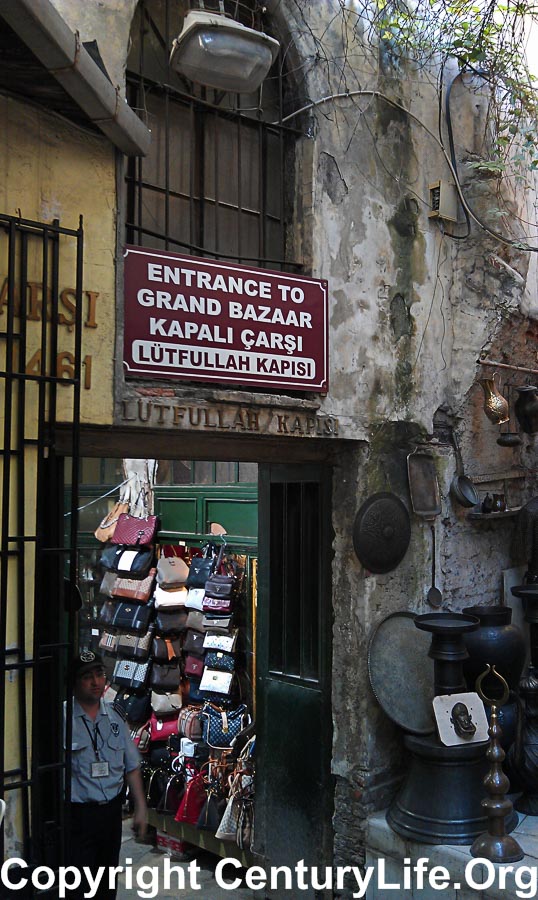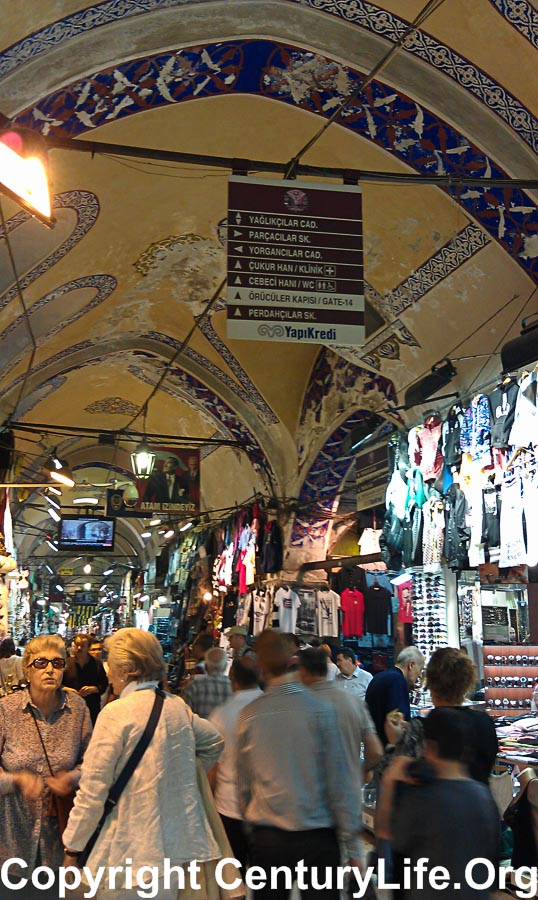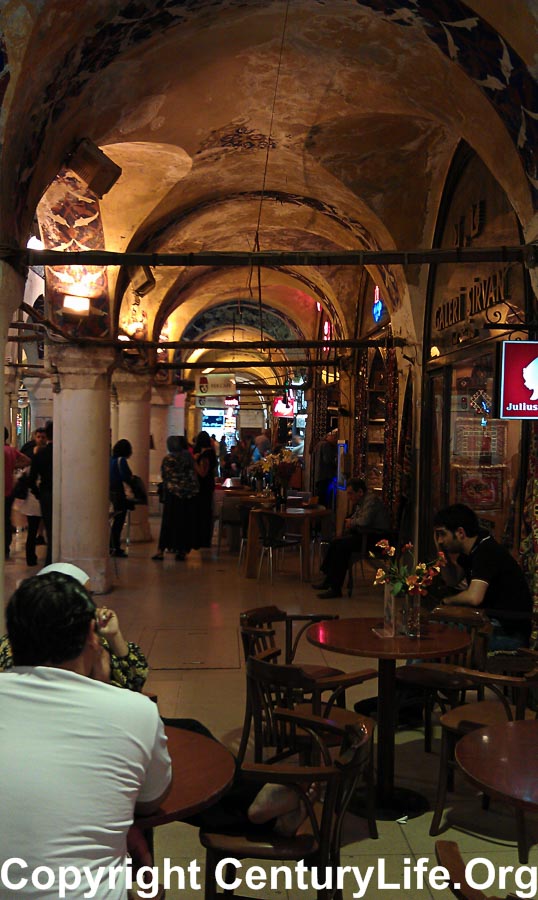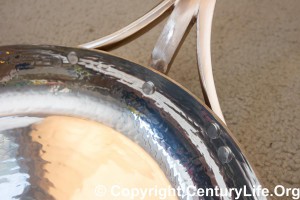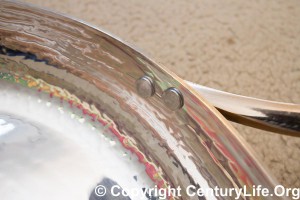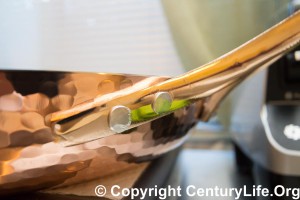
Note: If you have an induction stove, see De Buyer Prima Matera instead.
THE COMPANY
Soy Türkiye (pronounced “Soy TUR-KEY-eh“) is a Turkish cookware company based in Istanbul (not Constantinople). Türkiye is the Turkish word for the country of Turkey. Soy is a Turkish word that translates to “heritage” or “essence,” so Soy Türkiye means the “Heritage/Essence of Turkey.” The company makes Turkish coffee pots (cezves) as well as cookware–including .999 solid silver cookware. That’s right, the entire vessel except the handle, made out of 99.9%+ pure solid silver, costing several thousand dollars apiece.
The backstory to Soy Türkiye is that a Turkish man by the name of Emir Ali Enç graduated from the University of Concordia in Canada in 2008 and was continuing his political science studies in Ankara in order to be a diplomat–just like the previous seven generations of his family. Indeed, both of his parents were diplomats. During his studies, Enç missed cooking on his mother’s copper pots and looked into getting his own, only to discover that most copper cookware is produced in Europe, mostly in France. (Why France? Because French Crusaders brought cookware coppersmithing back with them from what is modern-day Lebanon/Syria, but that’s a story for another time.)
Enç did not want to buy French copper. He decided to quit his studies and to resurrect coppersmithing where it was born, in the Middle East.1 Enç apprenticed with a Syrian master coppersmith for six months. Enç then returned to Turkey to start his own coppersmithing company. He only had the equivalent of $7,000 saved up, but he won another $7,000 on Turkey’s equivalent of the game show Who Wants to be a Millionaire?, and his skeptical parents invested yet another $7,000. Given low Turkish rental costs, that was enough to start a workshop in the Büyük Han (Big Inn) in Istanbul’s Grand Bazaar, a three-level structure surrounding a central courtyard built in 1678.2
Soy Türkiye launched in 2010 and immediately ran into trouble. Enç was learning as he manufactured, so earlier-vintage Soy products were not as good as they would be in later years. The global recession dampened demand. At one point, Enç had to borrow money from a distributor to make payroll, and Soy could have gone bankrupt if the distributor said “no.”
The distributor said yes, in exchange for a discount on its next shipment from Soy. Over time, Soy Türkiye stabilized. Soy climbed the learning curve of manufacturing and became increasingly famous for high-quality cookware, while the world climbed out of recession. By 2015, Soy Türkiye employed five artisans and had 17 distributors who exported to 37 countries. Soy’s production became limited by labor–Istanbul coppersmiths are old and few in number–so Enç began working with a local high school to develop a Soy apprenticeship program.
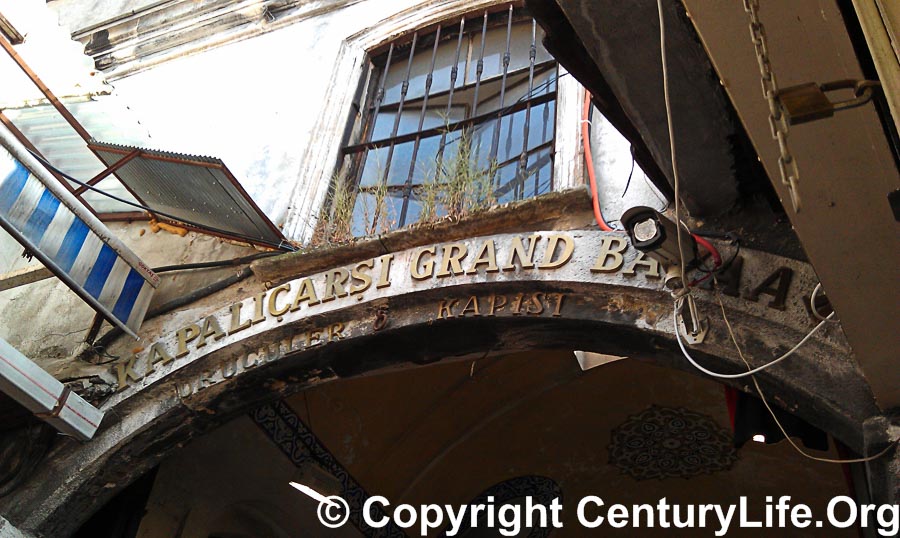
You may want to learn more about the company through this video showing how the company hand-makes all of their cookware (copper sheet cut into circles, then bent on lathes and hardened by hand-hammering) (NSFW Warning: at about 12 minutes into the video, Emir inexplicably drops an f-bomb):
How popular is Soy? Well, in the video above, the chef who ordered a fish kettle to add to his existing Soy Türkiye cookware is Gencay Ucok, who owns and runs Meze by Lemon Tree, a highly rated restaurant in Istanbul. Soy’s clientele even extends to Middle-Eastern royalty.
I last visited the country of Turkey before Soy Türkiye had made a name for itself, else I would have visited in person. (Those are my vacation photos above, of Istanbul’s Grand Bazaar.)
By the way, you know how Emir said in that video that his .999 silver will “basically” never melt on your stovetop? Um… see below for what happens when you overheat one of his pans.
THE PRODUCTS BEING REVIEWED: JEWELRY TO COOK ON
Up for review is Soy Türkiye’s 30cm (12 inch) diameter, 2.5mm-thick copper frying pan, but this review is applicable to Soy’s other products as well. All Soy copper cookware is 100% handmade and lined with your choice of tin or silver, for the same price regardless of lining type. If you do get a silver lining, it’s 0.015 mm thick silver plating. That does not sound like much, but can last for decades if you are careful to never use metal utensils. Stick with plastic or silicone spatulas only. And if you cook things with bones in them, try to avoid dragging the bone across the silver. Basically treat it as if it were a Teflon pan and you should be fine.
If you can splurge on only one piece of cookware, make it a large-diameter (26cm+ diameter) frying pan. Frying pans are used for searing and also have to spread heat horizontally farther than any other piece of cookware, so you want something with high thermal conductivity, like copper. Furthermore, frying pans should have heat-conductive sidewalls because you want the entire cooking surface to be the same temperature, or close to it. (Yes you can stir to make up for thermal differences, but some foods can’t be stirred easily, like long bacon strips, or fish fillets that are stuck to the pan. And you want to be able to cook on the sides and also not have eggs or pancakes runny or overcooked along the edges.)
RATINGS
For an explanation of ratings methodology, click here.
Overall Rating for Gas Stoves: 3.8/5 Very Good.
Overall Rating for Electric Coil/Smoothtop Radiant Stoves: 3.3/5 Good.
Cleanup: 3/5 Good. I typically only give perfect (5 out of 5) scores to nonstick pans. A well-polished stainless steel pan rates a 4. The reason for the lower score for the silver-lined pan I’m reviewing is because silver is about as sticky as stainless steel, but you can’t resort to using Bar Keepers Friend or any other abrasive because the silver is softer than steel, and the silver lining is only 15 microns (0.015 mm) thick.
Instead, you will need to use nonabrasive cleaning techniques:
- Deglaze pans. Deglazing means pouring an ounce or more (depending on the pan size) of water, wine, or some other thin fluid into the pan while it’s hot, but not so much that it warps the pan. Pour just enough to get the pan to bubble off most of the stuck-on bits (called the fond in French); use silicone/plastic spatulas/tongs/etc. to help scrape off the fond. If you do this with the remnants of proteins like steaks, you can make a delicious pan sauce to pour over the steak.
- If that doesn’t work, pour a larger amount of water into the pan and boil it off. You can also soak the pan overnight before doing so.
- It’s safe to swish vinegar around the interior of the pan and to let it sit for a while. You can even deglaze the pan with vinegar. The acidic vinegar can pry some stubborn stains off.
- Scrubbing with a soft sponge (rated nonstick-safe, such as Scotch-Brite 3M Non-Scratch Scrub Sponges
) and soap and water is safe.
- It’s okay to leave tiny traces of food in the pan that simply won’t come off. Those don’t really pose a threat because a) microbes can’t grow on silver 3, and b) even if microbes could grow on silver, they will die the next time you preheat the pan, anyway.
Avoid using baking soda, BKF, metal polish, steel wool, or even the rough side of a scrubbie to clean this pan. Treat it like a Teflon pan. Abrasives, even relatively mild ones like baking soda and BKF, can wear away the silver lining, which is only 0.015 mm thick (which is actually pretty thick as far as silver plating goes, but a far cry from the typical 0.5 mm of rugged stainless steel found on a lot of cookware).
I would give a similar score for the tin-lined version because while tin might not be quite as sticky as stainless or silver in the first place, and while tin lining as applied to cookware is much thicker than silver lining, tin is even softer than silver, so you can’t resort to abrasives or hard scrubbing.
By the way, a nice side effect of copper is that it’s toxic to microbes, just like silver. For instance, more than 99.9% of E. coli and MRSA bacteria die within 2 hours of contact with 99.9% pure copper. Even alloys with lower percentages of copper, such as brass and bronze, will kill microbes (albeit less efficiently).4 Copper even kills fungus and the flu. In comparison, such microbes can persist for weeks on stainless steel.
What this means is that the Soy pan’s handle–made from sand-casted bronze that contains a lot of copper–will self-clean even if not thoroughly washed. (As for the rest of the pan, the non-handle part of the pan gets much hotter during cooking, and the heat will destroy microbes much faster than the natural antimicrobial properties of copper/bronze/silver.)
Durability: 4/5 Very Good. Let’s begin with how I heated this pan on a full-blast 12,000 Btu-equivalent burner for five minutes, to the point where the silver started to tarnish. That’s right, I took a beautiful, brand-new, silver-lined pan and turned it into this:

The pan reached as much as 900F at the hottest parts of the pan (the bottom perimeter of the cooking surface gets hottest on a gas burner). But the silver didn’t melt. Pure silver has a melting point of about 1760F/960C.
But you know how silver reacts with the trace amounts of sulfur (e.g., hydrogen sulfide) in the atmosphere to create black tarnish over long periods of time? That tarnishing chemical reaction accelerates dramatically as you go up in temperature. The portions of the pan that stayed cooler than ~800F had little to no tarnish, but the portions of the pan that went over that obviously darkened. (Is this tarnishing a problem in real life? Not really. About the only time you’d ever go above 500F is to sear a steak or something like that, and even then you’re not likely to go much hotter. So you should have no problem keeping this pan untarnished in normal use. I have not seen any tarnishing of the silver after weeks of normal use.)
I contacted Soy and apologetically asked how much it would cost to repair the pan. I did not tell them that I was a reviewer, so I got no special treatment. Much to my surprise, Soy offered to repair the pan for free–including shipping to and from Turkey, despite the obvious pan abuse. (Their warranty technically just covers normal household use.) I don’t know how long they can keep up that generous policy, but it’s still Soy’s warranty policy as of 2016.
Some pans that get heated to 900F would be damaged. Aluminum pans probably would have warped out of shape (aluminum melts at ~1170F). And copper lined with tin? Forget about it. Tin melts at about 450F, so heating to 900F would have ruined a tin lining for sure. Even lower-quality cladded steel pans may warp if heated to 900F. Yet the Soy pan survived with only a bit of tarnishing.
That said, you need to avoid using metal utensils in this pan. I would even avoid using bamboo utensils because bamboo is fairly hard. Stick with silicone or plastic utensils if you can help it.
Once the silver lining wears through and exposes copper, the pan will begin emitting copper into your food as you cook. A little copper is okay–in fact you need a very small amount of copper to live. But a lot of copper is toxic. So if you have, say, a square inch of copper peeking through, contact Soy to get your pan re-silvered.
If you chose to go with tin lining, you should follow the same plastic/silicone precautions as above, and also never overheat your pan beyond the melting point of tin (450F). You can get the pan re-lined by Soy, but it would probably be faster to find a domestic tin liner than to wait a few months for shipping and repairs and returning shipping. I recommend Rocky Mountain Retinning because their rates are reasonable and they have a good reputation for doing thick and good re-tinning jobs.
Moving on to other points of durability: the handle is made out of bronze and secured with five rivets made out of white copper hand-hammered into place (white copper is an alloy; it is made of copper mixed with about 10-35% nickel).
Speaking of hammering, the entire copper pan is hammered, except for the handle which is smooth. Hammering mildly stresses copper and makes the copper harder and more brittle. Unstressed copper has a regular, crystal structure at the molecular level and is thus softer and more pliable. That’s good for making copper wire, but not for cookware. For cookware, we want to shape the copper into its final form while it is soft, and then hammer/work-harden it into its final shape in order to withstand wear and tear better.
I wound up giving this pan a high durability rating despite the relatively soft lining because the softness of the lining is more of a cleanup issue, and otherwise the pan is rock-solid and even survived 900F temperatures. But I can’t give it a perfect score because soft linings are not purely a cleanup issue. E.g., bones in the fish/meat you are cooking can scratch up the pan, too, not just abrasive cleaners.
Even heating: 5/5 Excellent (Gas), or 4/5 Very Good (Electric). The mildly bumpy surface of the Soy Türkiye pan and super-low thermal emissivity of polished silver made it too hard to do an accurate thermal image of the pan. The softness and thinness of the silver layer meant that I didn’t want to use a thermocouple, either, as that would scratch the lining. (In hindsight I should have used the thermocouples on the wrecked pan prior to shipping it back. Oops. Lost opportunity.) There are other workarounds, but then the thermal measurements wouldn’t be apples-to-apples against all of my other thermal measurements. So… sorry, but this pan isn’t going to be in the thermal (even heating) rankings. That said, with 2.5 mm of copper at the base of the pan, you can bet that this pan would have been right near the top. And visually we can see it’s a very even-heating on gas. To the right is a photograph of the exterior of the overheated pan. The splotch is where the hot butane hit the pan directly. The rest of the discolored copper was even in color–right up to the rim.
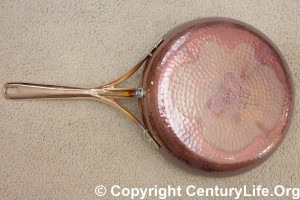
On electric coil or smoothtop, this pan’s bumpiness prevent ideal thermal contact with the heating element and can create air pockets which act as insulators. I’ve tested this pan on an induction converter disc before and it was rather bad, charring the paper towel. This pan doesn’t work as well on flat surfaces and begs to be used on gas.
Heat retention is very good with this pan, which has roughly 20% more heat capacity than an All-Clad Stainless pan of equivalent size. A thinner pan will crash in temperature more if you throw in a cold slab of meat/fish, resulting in more time spent steaming and less time creating tasty browning.
What is remarkable about copper is how quickly it heats up and cools down when you turn the burner on or off, all while storing a good amount of heat. On a 12,000 Btu flame, which is comparable to the largest burner on a medium-priced residential gas cooktop, it only takes about one minute to get the pan up to a high enough temperature to fry eggs. Such quick heating saves time and money in the form of lower utility bills. For comparison, an All-Clad Stainless pan takes closer to two minutes, and it does so at the cost of heating less evenly and retaining less heat.
Handling and ease of use: 3/5 Good. Soy Türkiye claims that the handle is made out of a patented bronze that heats up as much as five times more slowly than European copper cookware with brass handles, and that their bronze handles won’t rust like cast iron handles can. (Though in fairness you can just coat cast iron handles in seasoning and then not worry about it after that.) Soy’s handle splits off into three tines that are secured with a total of five white copper rivets to the vessel of the pan. The handle gaps allow hot gases to flow up and through the handle rather than into the handle, which should keep the handle cooler for a longer period of time.
For short- to medium-length frying sessions, the handles never get uncomfortably hot to hold. But if you fry for ~12 minutes or so (depending on how high of heat you use), the handle does get too hot to hold. And in my experience, cast iron handles do not heat up that much faster than the bronze Soy handles, certainly not five times faster.
The handle is set at a slightly higher angle than many pans sold in the USA (see photo), so short people may find it more awkward to handle on high stoves. Ann, who is 5 foot 6, felt like she had plenty of clearance, so I’m going to go out on a limb and say that if you’re over 5 foot 2, you should have no problems, assuming typical cooktop height.
The worst part about the handle is that it’s too heavy and makes the pan unbalanced. An empty pan will sit flat–barely. But you really need food in the pan in order to have a decent margin for error. I think if Soy made a slightly thinner handle that weighed a bit less, it would make the entire pan more balanced and more comfortable to use.
The entire 30 cm Soy pan weighs 2670 grams (5.89 pounds) empty, though there is slight piece-to-piece variation because each pan is 100% handmade and unique. That’s twice the weight of an All-Clad Stainless 30cm pan (which weighs 1265 grams, or 2.79 pounds), so the Soy pan is pretty heavy when loaded with food and could probably use a helper handle. On the plus side, I found that bracing the handle underneath my forearm made for a secure grip, so I recommend holding it like that for maximum control.
The pan doesn’t have flared rims for less-drippy pouring, unfortunately. The company’s pots and rondeaus (saute pans with two short handles) do have slightly flared rims that should help a little bit in pouring.
Value: 4/5 Very Good. See Conclusion for why. Also, if you are attempting to use this on an electric coil or radiant stove, I’d reduce this score down to 2/5 “Poor” instead, because the pan will not lie perfectly flat and the bumpiness reduces thermal transfer efficiency. Lastly, such electric stoves heat up and cool down slowly, reducing the “instant responsiveness” that copper pans have on gas stoves. That defeats the purpose of using copper to some degree.
Versatility: 4/5 Very Good. I measured the (mostly) flat cooking surface on the 30 cm frying pan to be nearly 9 inches in diameter, which is about average or just a touch below average for a pan of this size. The pan is 5.5 cm (2.17 inches) tall. The frying pan heights for 26 to 30 cm pans is 5.5 cm (2.17 inches). The frying pan height for 20 to 24 cm pans is 5.0 cm (1.97 inches).
In other words, these pans have decent amounts of flat floor space, which is important to avoid crowding. And they are tall enough to cook a decent amount of food.
Speaking of flatness, I would caution against getting these pans for electric coil or radiant stoves, since those demand flatter bottoms than gas stoves. I actually have two Soy pans, and neither sits perfectly flat, though they come close. Even if they were perfectly flat, the hammered bottoms make it so that the pan only makes decent, rather than good, contact with the heating elements. Lastly, such electric stoves heat up and cool down slowly, reducing the “instant responsiveness” that copper pans have on gas stoves. As previously noted, that defeats the purpose of using copper to some degree. The contact was still good enough that I had no problems cooking on electric coil, but the pan really comes to life on gas, since flames and hot gases don’t care as much about perfect flatness or bumpiness.
Both copper and silver are oven-safe to 500F+ (they have melting points well above 1500F). If you get the tin-lined version, don’t use them in the oven at anything over 300F to be safe (because unless your oven is calibrated, it can be way off and/or overshoot the target temperature that you set it to). Tin melts at 450F and can soften before then.
These pans are not dishwasher-compatible, nor are they induction-compatible. Dishwasher detergents will quickly make copper turn ugly colors, even if the copper retains its structural integrity. And copper is not induction-compatible by its very nature–you need ferromagnetic material for that.
CONCLUSION
Note: If you have an induction stove, see De Buyer Prima Matera instead.
I already made this point above, but I want to repeat that if you have anything other than a gas stove (e.g., electric coil, electric radiant “smoothtop,” or induction stove), then I would caution against getting these pans, because those stove types demand flatter bottoms than gas stoves.
If you do have a gas stove, or are planning on getting a gas stove, these pans are a good value, though not a slam dunk purchase because copper cookware is not for everyone.
The knock against copper pans is that they are relatively heavy, do not work on induction stoves, cost a lot, and require more upkeep if you want to keep them shiny (though many people allow the copper to develop a deep brown patina and rarely clean it).
Copper cookware is for folks who are okay with sacrificing a bit of modern convenience in exchange for unrivaled thermal responsiveness and the satisfaction of cooking on a metal (copper) which represents the pinnacle of traditional cookware. Copper cookware can be used as conversation starters and warm-colored kitchen decor in a way that other cookware can’t; stainless steel looks clinical in comparison.
If you’ve decided that you want to cook on copper, then Soy Türkiye’s cookware is among the best options (see also my review of Mazzetti copper and Mauviel 250c copper):
- You get silver lining for the same price as tin, and I would recommend the silver because of its much higher melting point (over 1760F, compared to 450F) and because silver is harder and more wear-resistant and Soy is offering a great warranty.
- The handles are made out of a bronze alloy which will not rust and will get hot more slowly than brass handles that you find on other copper cookware. But the bronze handles get hot only a little more slowly than cast iron handles.
- You get free lifetime re-silvering or re-tinning with purchase (that’s worth hundreds of dollars all by itself; it typically costs ~$100 to re-tin and over $100 to re-silver a 30 cm frying pan like this one).
- You are getting a 100% handmade item of heirloom quality.
- You get a free conversation piece whenever friends, family, etc. come over to your home. Each Soy pan is unique, has its own serial number, and is authentically-handmade, functional jewelry that you can cook on.
- Professional chefs and cooking enthusiasts have used copper cookware for literally thousands of years. The Middle East was the cradle of coppersmithing and produced copper cookware as early as 8,000 B.C. If you’re into history, it’s cool to cook in the same kind of pot that people were using 10,000 years ago. In theory, you could literally be cooking in the same pot, because about 98% of Soy’s copper and silver is from recycled sources.
But before diving into tin-and silver-lined cookware, make sure that it’s really what you want. Many people want something comfortable to cook with (good handles and balance), that is also easy to clean. Pans with stainless cooking surfaces let you use abrasives and scouring pads, won’t melt or get scratched by cooking meat with bones in it, and can be put into the dishwasher if necessary. If those factors are important to you, consider getting stainless-steel lined copper cookware instead, such as Mauviel’s M250c (reviewed here).
If you are still interested in tin- and silver-lined cookware, then take a look at the Soy Turkiye product list. (Sometimes you can find Soy Turkiye for sale on Ebay or on Amazon.com as well.) The most useful pieces to get in copper are the Soy Türkiye frying pans. The frying pan heights for 26 to 30 cm pans is 5.5 cm (2.17 inches). The frying pan height for 20 to 24 cm pans is 5.0 cm (1.97 inches).
Here are the specifications for their Sauté pans (2.5 mm thick except the 12 and 16mm diameter pieces, which are 2 mm thick):
- 20cm diameter, 6 cm height (7.9, 2.36 inches)
- 24 cm diameter, 7 cm height (9.5, 2.76 inches)
- 28 cm diameter, 8 cm height (11, 3.15 inches)
For saucepans (2.5 mm thick except for the 12 cm diameter saucepan which is 2 mm thick):
- 12 cm diameter, 7 cm height (4.72, 2.76 inches)
- 16 cm diameter, 9 cm height (6.3, 3.54 inches)
- 20 cm diameter, 11 cm height (7.9, 4.33 inches)
- 24 cm diameter, 13 cm height (9.5, 5.12 inches)
Saucepots (all 2.5 mm thick):
- 22 cm diameter, 12 cm height (8.7, 4.72 inches)
- 26 cm diameter, 14 cm height (10.2, 5.51 inches)
- 30 cm diameter, 15 cm height (11.8, 5.91 inches)
Rondeaus (all 3.0 mm thick):
- 24 cm diameter, 7 cm height (9.5, 2.76 inches)
- 28 cm diameter, 7.5 cm height (11, 2.95 inches)
- 32 cm diameter, 8 cm height (12.6, 3.15 inches)
Soy’s products generally do not come with lids. Note:
- Their stuff is all handmade and subject to slight size variations (my 30 cm skillet was more like 29.5 cm and would not take standard 30 cm lids); and
- Copper is one of the worst lid materials because it allows heat to pass through relatively easily compared to stainless steel or glass, so it takes longer to boil water if you use a copper lid than if you used a stainless or glass lid.
If you don’t already have other lids that will fit, I would recommend buying a universal lid such as this one.
Other Notes:
If you need a utensil that won’t damage the pan, I’d suggest adding a steel-reinforced silicone turner because:
- Metal utensils are too hard for tin- and silver-lined pans; they will scratch the pan’s lining.
- Plastic spatulas like nylon can soften/melt at frying temperatures.
- Wood utensils will eventually stain and break down and isn’t dishwasher safe, and the cheap ones disintegrate quickly. But it’s a good option as long as you keep replacing them when they wear out.
- Silicone is very durable.
After extensive testing, our recommendation is the OXO Good Grips silicone turner. This is also sold as the StarPack Ultra Flexible Silicone Turner set.
FOOTNOTES
